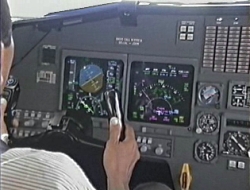UPDATED
SEP 14, 2010
Rio de Janeiro - Brazil
Santos Dumont airport(SBRJ) and Tom Jobim airport(SBGL)
UPDATED
The plane was flying at 10.000 feet upon failure.
Learjet 55C PT-LXO tookoff from runway 02R at Santos Dumont Airport(SBRJ) destination to Tom Jobim airport(SBGL). See graphs below.
It started emergency return from Jacarepaguá airport(SBJR) vicinity and the crew informed by radio to Approach Control RIO the plane was coming back due to technical troubles maybe electrical failure.
The aircraft went into SBRJ visual airtraffic circuit via waypoint LAGOA Rodrigo de Freitas, it outlined Santos Dumont aerodrome for runway 02 R landing.
There are evidences all pilots were listening to Santos Dumont Tower but did not transmitted their intentions.
After touchdown strong trails of smoke were seen from plane tires. Short of runway end the plane steered off runway centerline to the left and then steered off to the right turning its tail to runway 20 Left and fell into sea some meters away from runway threshod.
Pilot applied thrust to plane engines and the plane got sailing on sea surface and reached the embankment rocks of runway 20 threshold. All three person on board were rescued by a flatboat crew.
As regras para RETORNO e POUSO em EMERGÊNCIA são claras.
O Pilot-Flying deve escolher a pista de pouso mais longa nas proximidades.
O aeroporto Tom Jobim (SBGL) tem 2 pistas:
a pista com cabeceiras 15 e 33tem 3180 metros e
a pista com cabceiras 10 e 28 que tem 4000 metros
Learjet 55
Prior to takeoff, ALWAYS check the 3 Killer Items
TRIM - FLAPS - SPOILERS
These things can kill you before you have time to fix them
These things can kill you before you have time to fix them
Sistema Elétrico Lear 55
"AC" Electrical System
The Lear 55 is equipped with two inverters. Either one can supply AC power to all items on the aircraft that require it. They normally operate in parallel, but if one fails, the other picks up the remaining load automatically. An AC paralleling unit aligns the phase of the two inverters to make them work in parallel.
The AC items on the Lear include: Gyros, Autopilot, Altitude Alert, Mach trim system, Nosewheel Steering, Engine pressure gauges, and a few other items that vary from aircraft to aircraft.
Emergency Battery
If you experience loss of all main DC bus power for any reason, remember the following:
1. Emergency battery switch to ON. Landing gear extension will be normal except for the loss of the red gear door warning lights.
2. Landing gear warning horn will be inop.
3. Engine stator and nacelle lip heat are on.
4. Wing and tail anti-ice, pitot static, and angle of attack probe heat will be inop.
5. Windshield Heat will fail in the last position selected.
6. Tank to tank fuel transfer will not be possible if crossflow valve was closed at time of power loss. If crossflow valve was open, the boost pumps will fail, making pressure fuel transfer impossible, however, the crossflow valve will remain open, allowing some fuel transfer due to a very reliable power source called gravity.
7. The AC electrical system will be inop as it receives it's power from the DC system.
8. The hydraulic system will be inop, except for the landing gear and flaps, as their control circuitry is powered by the emergency battery when the "ON" position is selected.
9. Nosewheel steering will be inop, as it requires both AC and DC electrical power.
10. Anti-Skid system is inop.
"DC" Electrical
The Lear Jet 55 DC electrical system is only slightly more complex than the earlier models. It consists of: Two batteries, usually one, but sometimes two standby batteries, two starters, two generators, several busses, some relays, current limiters, quite a few circuit breakers, and two battery switches. The main difference between the 30 series (and some later 25's) is the added "Essential" busses. They are busses that can still receive battery power with both current limiters blown.
The current limiters connect the generators to the battery bus. The starting current goes through the start relay, and does not pass through the current limiter. The current that recharges the batteries does. If you blow a current limiter other than due do an electrical short, it will probably be just after engine start when you put the first generator online. Because the batteries are in a discharged state, they want all of the electrons they can eat. This is sometimes more than the current limiters can take.

Não existem tipos de EMERGÊNCIA, quer seja elétrica, eletrônica, hidráulica, mecânica ou até fogo nos motores, que possa mudar o conceito de Segurança de Voo na escolha da pista MAIS LONGA para retornar e efetuar POUSO em EMERGÊNCIA.
Todas aeronaves de transporte de passageiros têm capacidade para voar em EMERGÊNCIA e seus circuitos ELÉTRICOS e ELETRÔNICOS têm suporte de BATERIAS para voarem 30 minutos.
Esta é a condição primordial para CERTIFICAÇÃO de aeronaves de tranporte de passageiros. E esta energia elétrica para voar 30 minutos em EMERGÊNCIA, é suprida exclusivamente pelas baterias, as quais mantêm-se carregadas durante todo o voo.
Sistema Hidráulico Lear 55














Nenhum comentário:
Postar um comentário